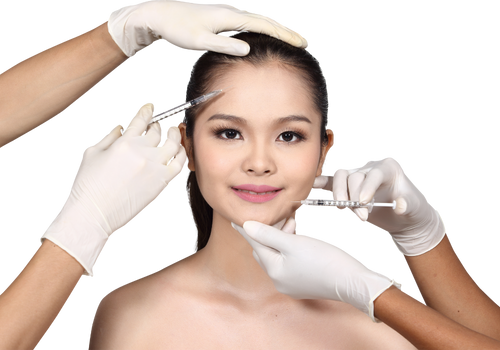
During youth, the shape of the cheeks and chin in particular provides the face with an inverted triangle shape. However, with aging, the bone structure in the face collapses, fat and connective tissue decrease. Resultç As a result, the inverted triangle structure on the face deteriorates with volume loss. This volume loss causes wrinkles, sagging and groove appearance in the facial area. enables its formation. As a result of advances in modern medicine, dermal fillers have begun to be used to fill these volume losses. The demand for filler applications has increased day by day due to the fact that they are more economical compared to surgical procedures, can be applied in outpatient clinic conditions, and can provide fast results with minimal side effects. In this method, many permanent or temporary substances such as the person's own fat tissue, collagen, hyaluronic acid, hydroxyapatite, hydrophilic polycylamide gel can be used. The advantage of temporary substances over permanent substances is that they dissolve over time and are eliminated from the body. Permanent substances, on the other hand, may react during application or after a period of time and may become disturbingly noticeable as they cannot adapt to changing facial lines over time. The most preferred fillers today are hyaluronic acid, calcium. hydroxyapatite (CaHa) and poly-L-lactic acid (PLLA) fillings.
The most frequently used substance today is hyaluronic acid. Hyaluronic acid is a polysaccharide, that is, natural sugar, and is found naturally in the human body and living things. It has very important functions such as cell division, providing lubrication of joints and keeping the skin taut. In addition, it has the ability to hold a thousand times more water than its own volume and to maintain its shape for a long time where it is injected, making it an ideal and most preferred filler material. Since there are no allergic reactions to these fillings, no allergy tests are required. The most frequently applied areas are; nasolabial lines (lines extending from the nose to the sides of the lips), lines going down from the edges of the lips (marionette lines), expression lines above the lip (perioral lines-cigarette lines) In addition to deep acne and scars, lip plumping, nose lifting, shaping of cheekbones, temples and jaw bones.
For what purpose and in which areas can fillers be applied?
- Providing lifting with temple filler
- Highlight the cheekbones
- Correcting nasolabial grooves
- Removing under-eye dents and bruises
- Reducing sagging lines at the corners of the mouth
- Clarifying the chin and chin line
- Shaping and plumping lips
- Eliminating wrinkles around the lips
- Shaping the eyebrow
- Removing minor deformities in the nose and lifting the tip of the nose
- Removing acne and scars
To whom is the application not recommended?
- Any history of allergy to the substance in the filling. history of anaphylaxis
- There is evidence of infection in the area to be treated
- Blood thinning medication usage
- Pregnancy and breastfeeding, uncontrolled diabetes, keloid predisposition
- Those who receive cancer treatment
What are the side effects?
The most common side effects are redness, edema, tenderness and bruising. Although redness disappears within 15-30 minutes, bruising may last up to 1 week. The most feared side effect is necrosis that may develop due to vascular damage. Apart from this, allergic reactions, granuloma formation, nerve damage, herpes virus, bacterial infections, biofilms and migration of the filler to another place can occur. maybe.
How long is the permanence of the filler?
The average permanence varies between 6-12 months, depending on the density of the product and the characteristics of the injected area. While it decreases faster around the moving muscles, the duration is longer in inactive areas such as the forehead and nose. It is recommended that the person not use excessive facial expressions, do sports, or chew extremely hard foods until 4 hours after the injection. In addition, it is aimed to provide complete support by eliminating the effects of light with the care creams and sun protection creams used together.


